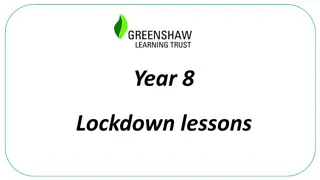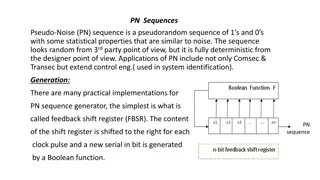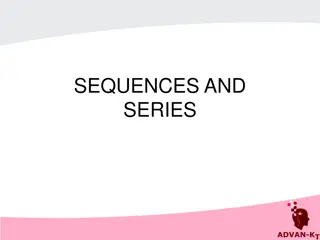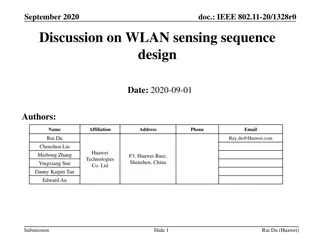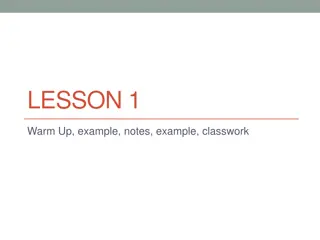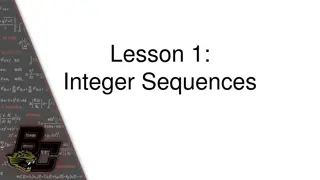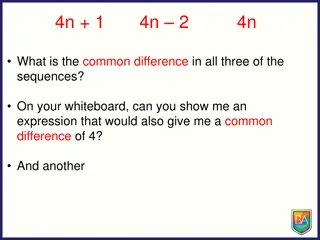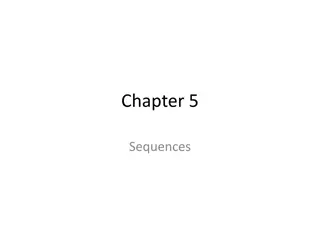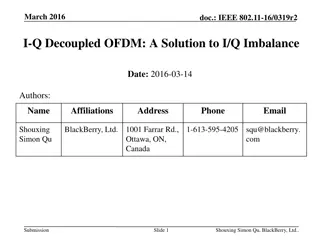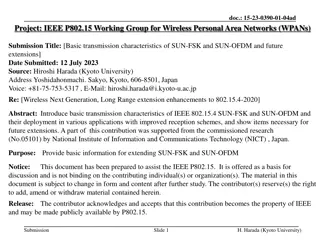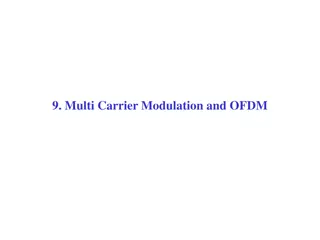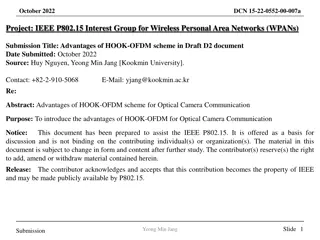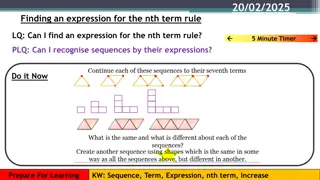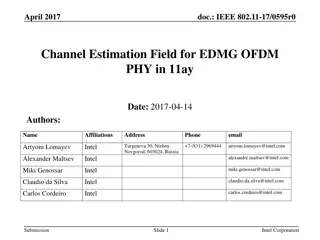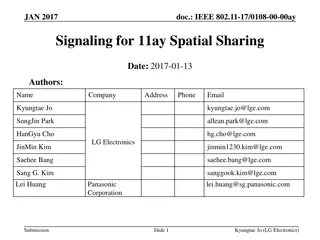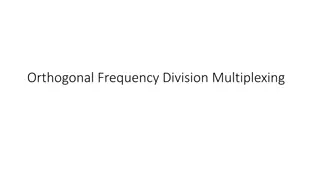
Proposed OFDM Pilot Sequences in IEEE 802.11-17/0661r0 Document
This document from May 2017 suggests frequency domain pilot sequences for EDMG OFDM PHY in IEEE 802.11-17/0661r0. It discusses considerations for pilot sequences in different channel bonding scenarios and emphasizes the importance of mutual orthogonal pilot sequences for robust performance. The presentation also covers criteria for designing the pilot sequence, including simplicity, mutual orthogonality, and low peak-to-average power ratio (PAPR).
Download Presentation

Please find below an Image/Link to download the presentation.
The content on the website is provided AS IS for your information and personal use only. It may not be sold, licensed, or shared on other websites without obtaining consent from the author. If you encounter any issues during the download, it is possible that the publisher has removed the file from their server.
You are allowed to download the files provided on this website for personal or commercial use, subject to the condition that they are used lawfully. All files are the property of their respective owners.
The content on the website is provided AS IS for your information and personal use only. It may not be sold, licensed, or shared on other websites without obtaining consent from the author.
E N D
Presentation Transcript
May 2017 doc.: IEEE 802.11-17/0661r0 OFDM Pilot Sequences in 11ay Date: 2017-05-10 Authors: Name Affiliations Address Phone email Sunwoong Yun LG Electronics Seocho LG sunwoong.yun@lge.com R&D Lab, Korea SungJin Park LG Electronics allean.park@lge.com Saehee Bang LG Electronics saehee.bang@lge.com JinMin Kim LG Electronics jinmin1230.kim@lge.com Jinsoo Choi LG Electronics js.choi@lge.com Sanggook Kim LG Electronics San Diego sanggook.kim@lge.com /California/ US Slide 1 LG
May 2017 doc.: IEEE 802.11-17/0661r0 Introduction This presentation proposes frequency domain pilot sequences for EDMG OFDM PHY Slide 2 LG
May 2017 doc.: IEEE 802.11-17/0661r0 Considerations of Pilot sequences in 11ay(1/2) Considering channel bonding, frequency domain pilot sequence for EDMG OFDM PHY should be newly defined for each channel bonding case (NCB=2/NCB=3/NCB=4) Since the maximum number of spatial streams per STA is eight as defined in draft, pilot sequences up to 8 streams should be defined We assume that For single channel transmission, the number of pilot subcarriers is 16 as same as 11ad For channel bonding transmission(CB>1), the number of pilot subcarriers is proposed in [1] as follows 2CB : 16*2 + 4 = 36 3CB : 16*3 + 4*2 = 56 4CB : 16*4 + 4*3 = 76 Slide 3 LG
May 2017 doc.: IEEE 802.11-17/0661r0 Considerations of Pilot sequences in 11ay(2/2) In [2], they show simulation results that mutual orthogonal pilot sequence between spatial streams may give more robust performance(i.e. residual CFO estimation) for correlated channels Orthogonal pilot sequence design makes pilot tracking more robust against various scenario Slide 4 LG
May 2017 doc.: IEEE 802.11-17/0661r0 How to design the pilot sequence(1/3) We consider criteria on how to design the pilot sequence 1. Simple extension property Considering HW complexity, extension method is more desirable than independent sequence for each CB 2. Mutual orthogonality For 8 mutual orthogonal sequences, at least sequence of 8 length(i.e. ?8(????, ) ) is needed 3. Low PAPR When we consider above, We propose to define only ?12????, & ?16(????, ) to make pilot sequence for all CB factor With ?16(????, ) and ?12(????, ) , it is possible to make mutual orthogonal sequences by simple way as described in next slide Slide 5 LG
May 2017 doc.: IEEE 802.11-17/0661r0 How to design the pilot sequence(2/3) The pilot sequence for each channel bonding cases is defined in Table1 below The pilot sequences ???(????, ) and ???????, are defined at the next slide Pilot sequences for each channel bonding ??? 1 2 3 4 ?16(????, ) ?36(????, ) = [?12(????, ) ?12(????, ) ?12(????, )] ?56(????, ) = [?16(????, ) ?12(????, ) ?12(????, )?16(????, )] ?76(????, ) = [?16(????, ) ?16????, ?12(????, ) ?16(????, )?16(????, )] Table1. Definition of pilot sequence for each CB Slide 6 LG
May 2017 doc.: IEEE 802.11-17/0661r0 How to design the pilot sequence(3/3) The pilot sequences ???(????, ) and ???????, are defined in table 2 below ???(????, ) is proposed in [3] ???? 1 ?16(????, ) ?12(????, ) [ 1 1 1 -1 1 1 -1 1 1 1 1 -1 -1 -1 1 -1] [-1 +1 -1 +1 +1 -1 -1 -1 -1 -1 +1 +1] [-1 -1 -1 1 -1 -1 1 -1 1 1 1 -1 -1 -1 1 -1] [+1 -1 +1 +1 -1 -1 -1 -1 -1 +1 +1 -1] 2 [-1 -1 -1 1 1 1 -1 1 -1 -1 -1 1 -1 -1 1 -1] [-1 +1 +1 -1 -1 -1 -1 -1 +1 +1 -1 +1] 3 [1 1 1 -1 -1 -1 1 -1 -1 -1 -1 1 -1 -1 1 -1] [+1 +1 -1 -1 -1 -1 -1 +1 +1 -1 +1 -1] 4 [-1 -1 1 -1 -1 -1 -1 1 -1 -1 1 -1 1 1 1 -1] [+1 -1 -1 -1 +1 -1 -1 +1 -1 +1 -1 +1] 5 [1 1 -1 1 1 1 1 -1 -1 -1 1 -1 1 1 1 -1] [-1 -1 +1 -1 -1 -1 +1 +1 -1 -1 +1 +1] 6 [1 1 -1 1 -1 -1 -1 1 1 1 -1 1 1 1 1 -1] [-1 -1 -1 +1 -1 +1 -1 +1 +1 +1 +1 +1] 7 [-1 -1 1 -1 1 1 1 -1 1 1 -1 1 1 1 1 -1] [-1 -1 -1 -1 +1 -1 +1 -1 +1 +1 +1 -1] 8 Table2. Definition of ???????, and ???(????, ) Slide 7 LG
May 2017 doc.: IEEE 802.11-17/0661r0 Simulation Results :PAPR(1/5) We checked PAPR to verify that proposed OFDM pilot sequences have low PAPR property The number and location of data, DC and pilot subcarriers are based on [1] Data : Random data with 64QAM modulation 4 times up-sampling Slide 8 LG
May 2017 doc.: IEEE 802.11-17/0661r0 Simulation Results :PAPR(2/5) Data part PAPR with each stream s pilot sequences for 1CB Slide 9 LG
May 2017 doc.: IEEE 802.11-17/0661r0 Simulation Results :PAPR(3/5) Data part PAPR with each stream s pilot sequences for 2CB Slide 10 LG
May 2017 doc.: IEEE 802.11-17/0661r0 Simulation Results :PAPR(4/5) Data part PAPR with each stream s pilot sequences for 3CB Slide 11 LG
May 2017 doc.: IEEE 802.11-17/0661r0 Simulation Results :PAPR(5/5) Data part PAPR with each stream s pilot sequences for 4CB Slide 12 LG
May 2017 doc.: IEEE 802.11-17/0661r0 Conclusion Since the maximum number of spatial streams per STA is eight in 802.11ay, 8 pilot sequences should be defined for 8 streams Mutual orthogonality between streams should be considered We propose that pilot sequences for 2CB, 3CB, 4CB with ???(????, ) and ???????, 2CB : ?36(????, ) = [?12(????, ) ?12(????, ) ?12(????, )] 3CB : ?56(????, ) = [?16(????, ) ?12(????, ) ?12(????, )?16(????, )] 4CB : ?76(????, ) = [?16(????, ) ?16????, ?12(????, ) ?16(????, )?16(????, )] Slide 13 LG
May 2017 doc.: IEEE 802.11-17/0661r0 SP/M Do you agree : to define OFDM pilot sequences for NCB>1 as described in (11- 17-0712-00-00ay-30 6 1 OFDM Pilot sequences)? Slide 14 LG
May 2017 doc.: IEEE 802.11-17/0661r0 Reference [1] 11-17-0597-00-00ay 30 6 1 OFDM Signal Parameters [2]Aoki, T.; Sandell, M.; , "Analysis of pilots for residual frequency offset estimation in MIMO OFDM systems," Wireless Communications, IEEE Transactions on , vol.8, no.3, pp.1128-1132, March 2009. [3] 11-17-0627-01-00ay OFDM Pilot Definition in 11ay Slide 15 LG

